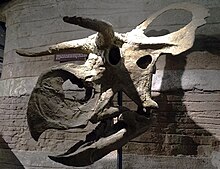
Back ناسوتوسيراتوبس Arabic Nasutoceratops Czech Nasutoceratops German Nasutoceratops titusi Spanish Nasutoceratops Finnish Nasutoceratops French נסוטוצרטופס HE Nasutoceratops Hungarian Nasutoceratops titusi Italian ナーストケラトプス Japanese
| Nasutoceratops Temporal range: Campanian,
| |
|---|---|

| |
| Reconstructed skull at the Arizona Museum of Natural History | |
| Scientific classification | |
| Domain: | Eukaryota |
| Kingdom: | Animalia |
| Phylum: | Chordata |
| Clade: | Dinosauria |
| Clade: | †Ornithischia |
| Clade: | †Ceratopsia |
| Family: | †Ceratopsidae |
| Subfamily: | †Centrosaurinae |
| Tribe: | †Nasutoceratopsini |
| Genus: | †Nasutoceratops Sampson et al., 2013 |
| Type species | |
| †Nasutoceratops titusi Sampson et al., 2013
| |
Nasutoceratops is genus of ceratopsid dinosaur that lived in North America during the Late Cretaceous period, about 76.0–75.5 million years ago. The first known specimens were discovered in Utah in the Kaiparowits Formation of the Grand Staircase–Escalante National Monument (GSENM) from 2006 onwards, including a subadult skull with a partial postcranial skeleton and rare skin impressions and two other partial skulls. In 2013, the subadult was made the holotype of the new genus and species Nasutoceratops titusi; the generic name means "large-nosed horned face", and the specific name honors the paleotologist Alan L. Titus for his work at the GSENM. The dinosaur was noted for its large nose in news reports, and later featured in Jurassic World films.
The holotype skull of Nasutoceratops is approximately 1.5 m (4.9 ft) long, and its body length has been estimated at 4.5 m (14.8 ft), its weight at 1.5 t (1.7 short tons). Nasutoceratops is distinct in features such as the snout region being unusually deep but short from front to back, with the external nostril forming 75% of the skull length in front of the eye sockets. The nasal bones were possibly pneumatized (air-filled), which is unknown in other ceratopsids. Its nasal horn is low and blade-like while the brow horns are notable for pointing forward and being approximately 40% of total skull length; they are up to 457 mm (18.0 in), the longest known of any centrosaurine, and have been likened to those of a Texas Longhorn bull. The neck frill is almost circular with its widest point at the middle. The epiossifications on the margins of the frill are shaped like low crescents, and there is one at the midline at the top of the frill, unlike in other centrosaurines. Nasutoceratops was a basal (early diverging) member of Centrosaurinae, and may have formed a distinct clade within this group, Nasutoceratopsini, with its closest relatives.
The function of the deep front of the skull of Nasutoceratops is unknown, but may have been related to mastication. The functions of ceratopsian frills and horns have been debated, and include signalling, combat, and species recognition. The forward oriented brow horns of Nasutoceratops may have enabled interlocking with opponents, as in modern bovids. The Kaiparowits Formation dates to the late Campanian age and was deposited on Laramidia, an island continent, when North America was divided at the center by the Western Interior Seaway. This environment was dominated by wetlands and supported a diverse fauna, including other ceratopsians. Based in part on the relationship between Nasutoceratops and other centrosaurines from around the same time, it has been proposed that Laramidia was divided into dinosaur "provinces" with separate endemic species, but this has been contested.
© MMXXIII Rich X Search. We shall prevail. All rights reserved. Rich X Search